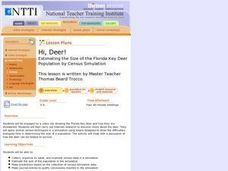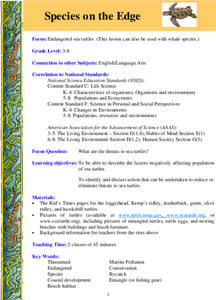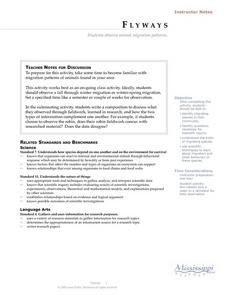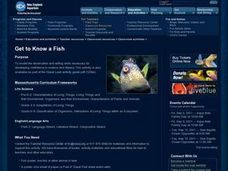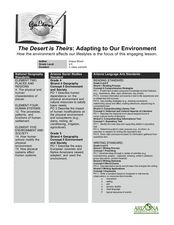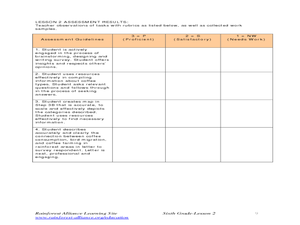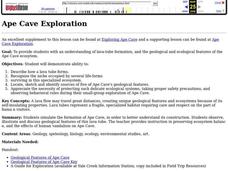Curated OER
Pika Chew
Students work in collaborative teams with specific roles, use the Internet to research the behavior and ecology of pikas, make predictions about survival rates of pikas in different habitats and organize their data in graphs.
Curated OER
Hi, Deer!
Students collect, organize by table, and examine census data in a simulation, estimate the size of the population in the simulation and make predictions based on the collection of census simulation data.
Curated OER
Species on the Edge
Students describe factors negatively affecting population of sea turtles, and identify and discuss action that can be undertaken to reduce or eliminate threats to sea turtles and other endangered species.
Curated OER
The Game of Life
Students describe what it means for a marine animal or fish to be threatened or endangered after playing game simulating extinction.
Curated OER
The Race
Students play game simulating route turtle hatchlings take from clutch to ocean, and describe threats hatchlings face and how this affects the marine turtle population.
Curated OER
The Watershed Quest
Students examine their connection to local watersheds. They describe the water cycle and list species living in their local watershed. They also draw a map of their community.
Curated OER
Design and Construction of an Eco-House
Students are able to design, construct, evaluate and recommend materials for planned Eco-house to be built on campus. They investigate about good design and plan for construction. Students have a greater knowledge and appreciation of...
Curated OER
Animal Migratory patterns
Students use field research and traditional research to identify migrating species of birds as well as their migratory patterns. Students generate a list of questions regarding migration and a plan to research the questions. A field...
Curated OER
A Basin Filled With Time
Students use fossil leaves and a mathematical formula to study climate change. In this climate change and fossil lesson plan, students determine the differences in temperatures during two different times during the Cenozoic era using...
Curated OER
Amazonian Travel Brochure
Students create a brochure. In this Amazon research lesson, students research a tourist attraction in the Amazon and develop a travel brochure.
Curated OER
Where are all the Animals?
Students view animals that camouflage at the Shedd aquarium website. In this camouflage lesson, students recognize that there are different types of camouflage, cryptic coloring, counter-shading, warning coloration and mimicry. Students...
Curated OER
Guetemala's Changing Forest
Eighth graders compare their local ecological zone to the tropical rainforest. In this natural ecology lesson, 8th graders complete an activity about the differences in ecological zones. They compare their biome to the Guatemalan...
Curated OER
Camouflage
First graders learn how plants and animals adapt to their environments. In this camouflage lesson plan, 1st graders watch a movie that explains animal camouflage, design a butterfly that blends into a classroom habitat, create a...
Curated OER
Get to Know a Fish
Students discover the anatomy of a fish by identifying its body parts. In this oceanography lesson plan, students view a live fish in their classroom and draw a poster of the fish one body part at a time while identifying it....
Curated OER
Ecology Scavenger Hunt
Who doesn't love a scavenger hunt? Have your class complete a scavenger hunt to become familiar with ecology in this engaging instructional activity that has them organize their items on a paper bag to illustrate information....
Curated OER
The Desert is Theirs: Adapting to Our Environment
Students determine how animals and people adapt to the desert environment. In this desert lesson, students review vocabulary about the desert and how humans have to make changes to accommodate their environments. They listen to and...
Curated OER
Nature's Recycling Program
Learners identify what materials make up compost. In this science of recycling lesson, students explain the benefits of composting determine how compost is a good plant fertilizer.
Curated OER
Whose Breakfast isn't for the Birds?
Students explore coffee production. In this cross-curriculum rainforest ecology lesson, students research regions where coffee comes from and investigate how the native birds in the rainforest are effected by coffee...
Curated OER
Tropical Treehouse
Learners examine the tropical rainforest and issues involving the uses of rainforests. They explore the plants and animals that live in each level of the tropical rainforest. Students examine and discuss a case study involving the rights...
Curated OER
The Environments of Big Sur -- Which Do We Protect?
Students investigate the geological, climatic, and biological features of Big Sur. They watch a video, conduct Internet research, and create a script and images in the form of an outline in a simulation of an environmental group.
Curated OER
Ape Cave Exploration
Students simulate online the formation of Ape Cave, in order to better explain its construction. They observe, illustrate and discuss geological features of this lava tube.
Curated OER
Can You Find a Solution?
Students explore the topic of public conservation. In this Florida panthers lesson, students read a scenario about the endangered panther and collaborate to plan a way to protect the panther population. Students also participate in a...
Curated OER
Choose Your Defense: Spines, Vomit and Camouflage
Students investigate defensive mechanisms of insects and organisms. In this biology lesson, students draw imaginary caterpillars as well as imaginary parasites that will harm the caterpillar. Students utilize the Internet to...
Curated OER
Constructing A Food Web
High schoolers identify and explain the relationships within a food web. They use index cards to glue pictures of producers and consumers. On the back of the card, students name the organism, list the type of biome in which it is found.



